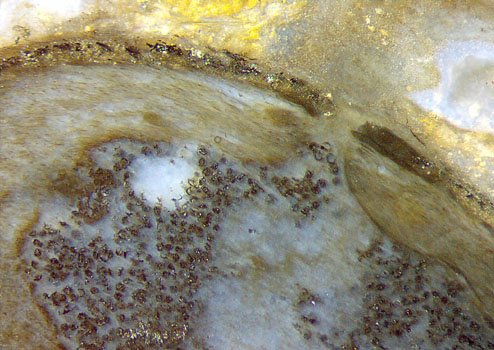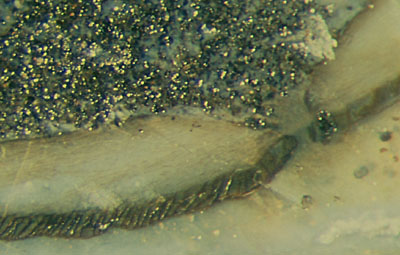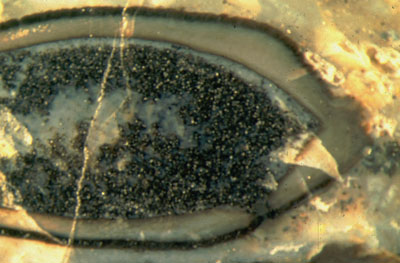The work of spore eaters

The sporangia most easily
recognized in the Rhynie chert are those of
Aglaophyton
(former Rhynia major).
These are often seen intact and full
or split and empty. Lengthwise splitting is usually regarded as the
only way of spore release [1,2]. This is not consistent with the
observation that sporangia are often (partiallly) empty but
not split. One could argue that the split is there but not seen on the
cut face. There is, however, a quite different explanation for the
missing spores: The sporangia are often invaded by spore eaters
entering through holes gnawed into the wall (Figs.1,2,3). Although the
creatures themselves have not yet been seen, the chewed-up spores and
partially eaten-off inner layers of the sporangia serve as evidence for
their (transient) presence.
Fig.1: Inclined section
of Aglaophyton
sporangium with
hole in the wall
and chewed-up spores. Width of the picture 3.4mm.
Figs.2,3 (below): Similar object as in Fig.1,
enlarged detail on the right.


The holes in the sporangia were apparently not noticed before as they
are not mentioned in the literature. Judging from the available fossil
material and taking into account that the chance of being cut
incidentally is much smaller for a small hole than for a lengthwise
split, it may be concluded that sporangia with holes and with spores
eaten up and dragged out are about as common in the Rhynie chert as
split sporangia with spores fallen out. (3rd Chert Meeting,
Chemnitz 2004.) There remains the challenge to find the elusive
creature responsible
for the damage done to Aglaophyton,
the most common plant in the Rhynie chert.
Samples: Fig.1: Rh2/75.11
H.-J.
Weiss
2004 2019
[1] David
S. Edwards : Aglaophyton
major, a non-vasular land-plant
from the Devonian Rhynie
Chert, Bot. J. Linn. Soc. 93(1986),
173-204.
[2] Dianne
Edwards : private communication (2003).
 |
 |
7 |






